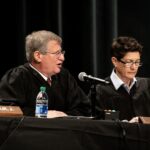Colorado Supreme Court critical of prosecutors’ misleading presentation of evidence

Kathryn Scott
Members of the Colorado Supreme Court on Tuesday pushed back against the notion that prosecutors can paint a misleading picture of a criminal defendant’s guilt by shielding the jury from evidence the defendant did not commit an offense after all.
In a pair of cases argued before the justices, the government asserted the state’s Court of Appeals was wrong to reverse two criminal convictions out of Arapahoe and Boulder counties. Each case featured comments the defendants made at the time of their alleged offenses that suggested their innocence, but jurors never heard that evidence.
Although out-of-court, hearsay statements are generally prohibited because they are unreliable, there are several exceptions to the prohibition as well as a “rule of completeness,” which dictates that a statement can be introduced in its entirety to avoid misleading jurors.
“This is the prosecution introducing part of the statement and excluding other parts — parts that are not favorable to the prosecution,” said Justice Carlos A. Samour Jr. “And the defendant is saying, ‘Time out. Hold on a second. If you’re gonna include those parts of the statement, you’ve got to include the other parts, too, out of fairness’.”
In the first case, an Arapahoe County jury convicted Charles Joseph McLaughlin of driving under the influence. Late at night, a motorist observed a pickup truck driving dangerously, eventually hitting a median and coming to a stop in a parking lot. The driver called 911 and an officer approached the pickup truck shortly afterward. McLaughlin was the only person around.
Jurors saw the officer’s body-worn camera video. The officer asked McLaughlin, “What happened to your truck?” and “Why did you pull in here to park?”
“I didn’t,” McLaughlin responded. “I didn’t drive anything. I’m sitting here trying to figure out what’s going on.”
What jurors did not know was that then-District Court Judge John E. Scipione allowed prosecutors to present a version of the video that edited out the parts of McLaughlin’s responses to the officer in which he suggested a woman was driving the truck, not him.
“I’m sitting here trying to figure out what’s going on because when she walked away and over there…” McLaughlin said in the full video. He also told the officer multiple times the unnamed woman “left” and “split.”
A three-judge panel for the Court of Appeals subsequently overturned McLaughlin’s conviction, finding the unedited video would have corrected jurors’ impression that McLaughlin had no explanation when the officer asked how his truck got into the parking lot. Further, Scipione was wrong to give McLaughlin the option of introducing the full footage, but simultaneously allowing the prosecution to talk about his prior convictions.
“The fact remains that he should not have been forced into the dilemma to begin with,” wrote Judge Ted C. Tow III for the appellate panel. “The harm caused by the court’s erroneous ruling — the unmitigated misleading of the jury — was thus not attributable to McLaughlin.”
On appeal to the Supreme Court, the government argued the Court of Appeals’ decision limited trial judges’ authority to prevent defendants from exposing juries to their self-serving, unreliable statements. But some members of the Supreme Court countered that it was problematic if prosecutors could selectively present evidence, then extract a price if a defendant asked for the full context.
“It just seems like it puts an enormous amount of power in the prosecution’s hands in this case to pick and choose what they want to include,” said Justice Melissa Hart.
Justice Richard L. Gabriel was the most vocal critic of the government for presenting a skewed version of the body-worn camera video, then claiming at trial McLaughlin had no explanation for what happened.
“He said what he said. And if the prosecutor wants to use the statement, the body-cam, put on the whole statement. That’s kind of what the point is here,” Gabriel said. “The impression was he had no answer for the question. But he did have an answer to the question.”
The justices directed far less critical questioning toward McLaughlin’s lawyer, who argued that prosecutors should not place defendants at a disadvantage in exchange for juries hearing “fair context.”
“In every criminal case, the prosecution would love to get on the evidence of the defendant’s prior convictions and attack the defendant’s reputation, but it doesn’t generally get to do that,” said public defender Casey Mark Klekas. “This case is about whether the prosecution can do that in every case, and all they’ll have to do is put forward misleading evidence and force the defendant to correct it.”
In the second case out of Boulder County, a jury convicted Jacob Vanderpauye of sexual assault. There was no dispute Vanderpauye was having sex with a very drunk woman when she woke up and said, “What are you doing? You’re raping me.” There was also no dispute that Vanderpauye was startled and replied, “I thought you said I could do anything to you.”
District Court Judge Bruce Langer barred jurors from hearing about Vanderpauye’s statement, claiming that self-serving hearsay was not admissible because defendants “sometimes make things up and paint things in a color that’s more beneficial to them.” He also did not believe Vanderpauye’s comments amounted to an “excited utterance,” which is an exception to the hearsay prohibition.
The Court of Appeals ordered a new trial, concluding Langer relied on a “nonexistent evidentiary rule” to exclude Vanderpauye’s statement and, alternatively, the statement also fit the legal criteria for an excited utterance.
The government argued to the Supreme Court that some statements can be “so self-serving” that they are unreliable. First Assistant Attorney General John T. Lee claimed Vanderpauye clearly had time to reflect upon his alleged sexual assault of the sleeping woman and invent a response for when she inevitably caught him.
Once again, the justices recognized the prosecution made it seem as if the defendant had no response in the moment to being accused of a crime, when existing procedural rules could have allowed the jury to hear Vanderpauye’s answer. Justice William W. Hood III acknowledged that “clearly the trial court did not apply the right test” to Vanderpauye’s statement.
“Trial courts may not ignore the rules, create new ones or exclude evidence simply because they do not believe it is credible,” argued Deputy State Public Defender River B. Sedaka.
Justice Maria E. Berkenkotter did not participate in the appeal. She handled the initial stages of Vanderpauye’s criminal case during her time as a Boulder County trial judge.
The cases are People v. McLaughlin and People v. Vanderpauye.












